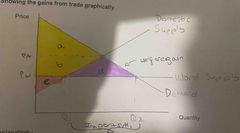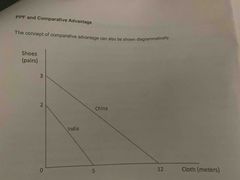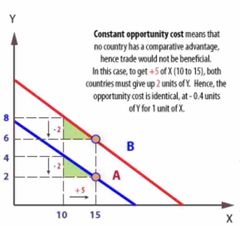![]()
![]()
![]()
Use LEFT and RIGHT arrow keys to navigate between flashcards;
Use UP and DOWN arrow keys to flip the card;
H to show hint;
A reads text to speech;
34 Cards in this Set
- Front
- Back
|
Give four reasons why countries trade |
-sell excess production and gain export revenue (injection into circular flow of income) -gain access to goods and services that are not produced or are expensive to produce in their home country -increased competition forces domestic producers to be efficient and improve quality -to gain economies of scale from specialising |
|
|
Explain how you could show the gains from trade graphically Price changes? Quantity changes? How is excess demand dealt with? Changes in consumer and producer surplus? Welfare loss or gain? |

PA is the domestic market price but with international trade, consumers can purchase goods at Pw. At world price consumers demand Q2 but domestic suppliers can only supply Q1. Therefore, M1 (difference between Q1 and Q2) is imported. Consumer surplus has grown from A to ABD. Domestic producer surplus has fallen from BC to B. Area D is the newly created welfare gain. |
|
|
Define Absolute Advantage |
Demonstrates the ability of a country to produce a good more efficiently than any other country. When countries have an absolute advantage in producing a product, it is logical to specialise in producing that good as it will increase world production. No opportunity cost is used to work it out. Just look at who makes more. |
|
|
How can countries benefit when they have an absolute advantage in all products? |
They use the concept of comparative advantage to decide what they should specialise in |
|
|
Define comparative advantage |
Used the concept of opportunity cost. The number of units of one good not madd in order to produce one unit of the other good. A country has comparative advantage if the opportunity cost of producing a good is lower than the opportunity cost for other countries |
|

In the following graph, state who has the comparative and absolute advantages |
China has an absolute advantage in both Cloth and Shoes. India has a comparative advantage in shoes while China has a comparative advantage in Cloth. |
|
|
Is there ever a situation where trade isn’t beneficial? Why would this look like on a PPF |

When both countries have the same opportunity cost of production. Both of their gradients on a PPF would be the same as in the following diagram |
|
|
Give 6 examples of real life comparative advantage |
● UK- Financial Services ● New Zealand- Lamb ● Saudi Arabia- Oil ● USA- Soy ● Japan- Cars ● Taiwan- Manufactured Electronics |
|
|
What four factors could lead to a country having comparative advantage in the production of a good? Give an example for each |
-Availability of raw materials (Countries like Saudi Arabia have oil easily available) -Climate (Coconuts grow easily in Caribbean) -Investment in R&D (Research and Development) (High levels of technology in places like Germany Lower costs of production) -Demographic I.e. availablity and cost of labour (China has large population so has cheap labour) -Higher labour productivity (countries like USA) |
|
|
Give 3 three criticisms of the theory of comparative advantage |
-Not realistic as it assumes no transport costs, homogenous products, constant exchange rates and no negative externalities -Doesn’t give ratio of trade which would detail who benefits more from trade. May not be fair. -Doesn’t mean countries should always be open to competition as they are in different stages of development. Infant industries e.g. in South Korea may need time to grow. |
|
|
What type of products do poorer countries tend to specialise in? |
Countries that specialise in agriculture are unlikely to benefit from technological progress as much as countries which specialise in manufacturing. |
|
|
How does the rate of technology change in different countries? |
Countries may be trapped selling primary products which have volatile prices (e.g. wheat) and are possibly finite |
|
|
Give two advantages of specialisation |
-higher world output from economies of scale -greater allocative efficiency as factors of production are being use for their most effective purpose |
|
|
Give 6 disadvantages of specialisation |
-comparative advantage is dynamic rather than static, and can be lost -could create high levels of structural unemployment if workers cannot retrain -Consumer tastes may change -Countries May want to be self-sufficient in case of war or natural disaster (especially with regard to food) -Other sectors of the economy may have an important social role e.g. farming hence CAP -Resources may be non-renewable e.g. oil |
|
|
Define Globalisation |
Refers to the increasing interdependence and integration of economic actors internationally . |
|
|
Give 7 characteristics of globalisation |
Increased interdependence Increased Global Trade Increased Levels of Migration Outsourcing and Global Supply Chains Global Capital Flows Growth of MNCs High Levels of FDI |
|
|
How has Transportation Costs contributed to the process of globalisation? |
Design of bigger ships has made it more efficient snd cheaper to move products all over the world |
|
|
How have changes in technology contributed to the process of globalisation? |
This makes it easier to sell abroad directly to consumers and cut firms communication costs, allowing outsourcing |
|
|
How has Reduction of Trade Barriers/Trade Agreements contributed to the process of globalisation? |
Trading blocs such as NAFTA or the EU has meant more tariff areas. With lower tariffs the price of imports has decrease making them more competitive. |
|
|
How has deregulation of financial markets econtributed to the process of globalisation? |
This makes it easier for firms to move money abroad in seconds for greater profit |
|
|
How have political changes contributed to the process of globalisation? |
The end of the Cold War and the opening of China meant more countries adopting an open market economy for trading. |
|
|
S |
Some countries such as China have made huge export revenues from selling abroad lifting millions out of poverty |
|
|
What are the negative ways in which Globalisation impacted Countries? |
Some feel it has threatened their way of life (cultural imperialism) Other areas such as the north of England have seen a rage decline from the ending of the inefficient industries, which as lead to a rise in inequality |
|
|
What are the negative ways in which Globalisation impacted Governments? |
Growth of MNC’s has lessened the power of individual governments as countries will be pressured to lower taxes and water down regulations to attach FDI. This increase of inter-governmental organisations and trade agreements has also reduced the sovereignty of governments. E.g. NHS |
|
|
What are the positive ways in which Globalisation impacted producers? |
Producers can reduce costs from outsourcing and can also find new markets to sell their products. |
|
|
What are the negative ways in which Globalisation impacted producers? |
In some countries high levels of migration has created a ‘brain drain’ where there are a lack of skilled workers |
|
|
What are the positive ways in which Globalisation impacted consumers ? |
Increased choice from buying foreign products. Reduced tariff barriers and global competition lowers prices making goods more affordable. |
|
|
What are the positive ways in which workers have been impacted by globalisation? |
Greater opportunities to migrate in search of higher wages |
|
|
What are the negative ways in which workers have been impacted by globalisation? |
Imports may replace traditional industries leading to unemployment. Increased competition from abroad might also lead to lower wages. |
|
|
B |
Increased trade leads to more transport and hence pollution. |
|
|
What are the positive ways in which the environment has been impacted by globalisation? |
Increased communication could lead to less travel and it may be efficient to import products rather than use resources growing them domestically e.g. chilies in Iceland |
|
|
What is deglobalisation? |
The process of diminishing interdependence and integration between certain units around the world, typically nation-states. It is widely used to describe the periods of history when economic trade and investment between countries decline. |
|
|
What has caused deglobalisation? |
-Transport Costs not falling -Falling FDI (especially from the Chinese) -Services are hard to trade -Increased Regulations -China being self-reliant |
|
|
What evidence is there of deglobalisation? |
Protectionism Brexit Decline of industry in U.K./US |

